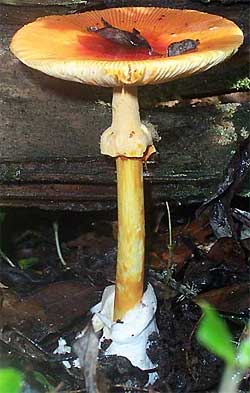 The Many Kinds of
The Many Kinds of 
The vast majority of fungi are not mushrooms such as the famously edible Ceasar's Mushroom, Amanita caesarea, at the right. Mushrooms are the reproductive organs of just one of many, many fungus kinds. The world of fungi is so unique and distinctive that it constitutes its own kingdom, the Fungi, equal in rank to the Plant Kingdom and the Animal Kingdom.
DIVISION or PHYLUM
CLASS
ORDER
FAMILY
GENUS
SPECIES
Though the concepts are sure to change, you can glimpse the diversity of the Fungus Kingdom by checking out a current list of the approximately 130 fungal orders, and how those orders are distributed among a dozen or so fungal classes and more or less 5-7 divisions, on Wikipedia's List of fungal orders page. The chart at the left will help keep these subdivisions straight.
THE DIVISION BASIDIOMYCOTA ("Higher Fungi")
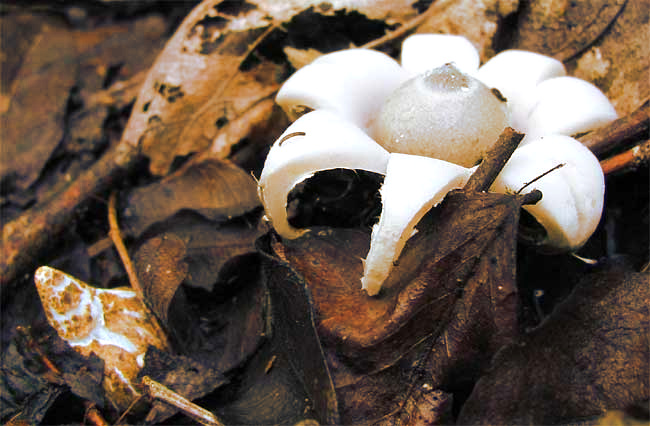
Despite the Fungus Kingdom's mind-boggling diversity, most of the eye-catching fungi in our neighborhoods are "higher fungi": They're members of the division Basidiomycota. Mushrooms, puffballs, stinkhorns, polypores, jelly fungi, boletes, chanterelles, earthstars, smuts, rusts and more all belong in this division. At the right, that's an earthstar, a member of this division, despite it looking very different from the Ceasar's Mushroom atop this page, which also is a "higher fungus."
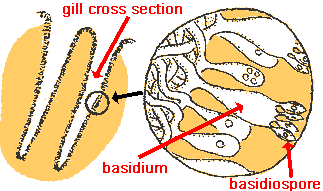
As the drawing at the left indicates, in this group, to accomplish sexual reproduction, spores -- more technically known as basidiospores -- are produced on microscopic, club-like structures called basidia (singular basidium). Basidia cover part of the fungus's reproductive structures. In gilled mushrooms the gills are covered with them. The accompanying diagram shows cross sections of two such gills.
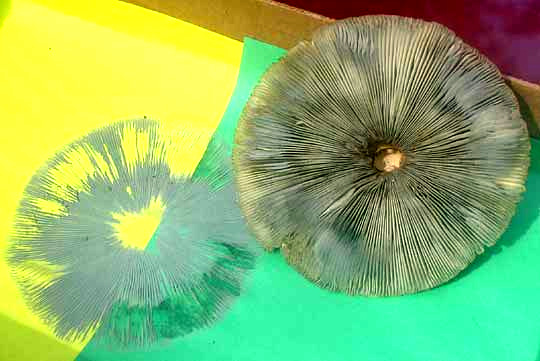
Basidospores detach from the basidia, drift down from the gills, and then are dispersed on wind currents. At the right you see a "spore print" of basidiospores fallen from a gilled mushroom's cap onto paper while spores were being released from the gills. On non-gilled fungi such as the above earthstar, basidia occur elsewhere on the fruiting bodies.
THE DIVISION OF ASCOMYCOTA ("Sac Fungi")
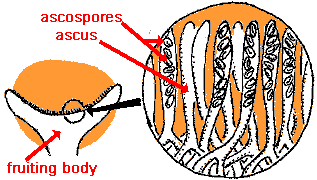
Also in our neighborhoods we may find "sac fungi," whose sexual reproduction with "ascospores," diagrammed at the left, is seen to differ greatly from that of the "higher fungi": The spores or produced inside asci (singular: ascus) or "sacs," not atop basidia. Morels, truffles, brewer's yeast and baker's yeast, dead man's fingers, and cup fungi are the most commonly encountered sac fungi. Many sac fungus species provide the fungal part of lichens.
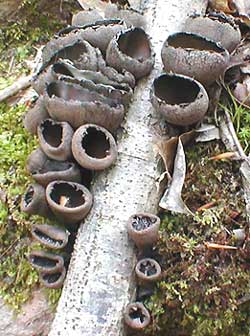
Cub fungi such as the Devil's Urn, Urnula craterium, at the right, usually are the most noticed sac fungi, unless you bake bread with baker's yeast, or brew beer with brewer's yeast.
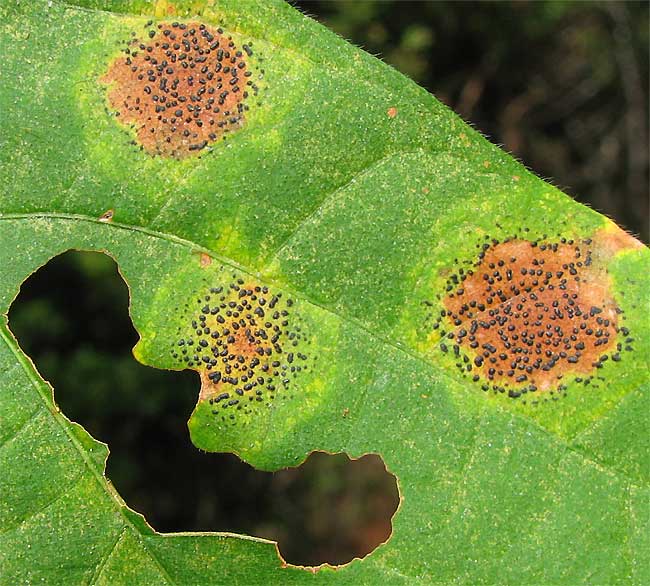
Less noticeable but more abundant in the landscape are such members of the sac fungi as shown causing Tar Spot Disease on a Bigleaf Maple leaf at the left. Such sac-fungus diseases often have interesting life cycles. Here' the Tar Spot Disease's life cycle:
The fungus overwinters on fallen leaves. In the spring, wind spreads spores from the leaf litter onto young, expanding leaves where the spores germinate. The resulting threadlike mycelium invades the leaves through stomata, the leaves' "air holes." During the summer, black "stroma" form on the upper leaf surface, as seen in the picture. Stroma are masses of fungal tissue with spore-bearing structures embedded in or on them. The stroma become wrinkly or convoluted. On the resulting ridges, "conidia" appear, which are asexual spores. Also on the stroma wrinkles, tiny, cup-like "apothecia" develop in the autumn, which sexually produce spores. Leaves fall onto the ground, then next spring the cycle begins again.
BEYOND THE TWO BIG DIVISIONS
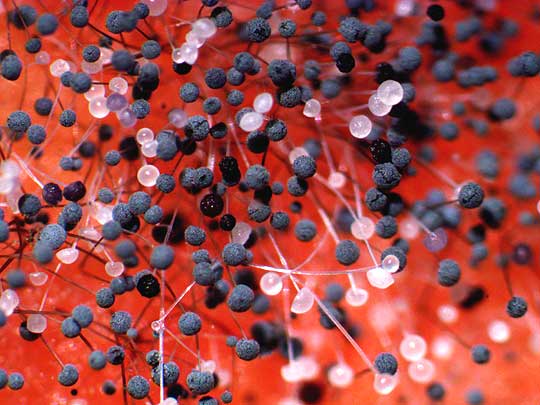
An orange winter squash was stored for so long that it got mushy and moldy. The mold was a fungus, shown at the right, and it was neither a "higher fungus" nor a "sac fungus," but rather a kind of "pin mold," of the division Mucoromycota. It's a species of the abundantly occurring -- though often not noticed -- genus Rhizopus. That genus embraces species which on plants are saprophytic (feeding on decayed tissue), or on animals are parasitic (feeding on living tissue). The picture shows the fungus at its peak of asexual spore production.
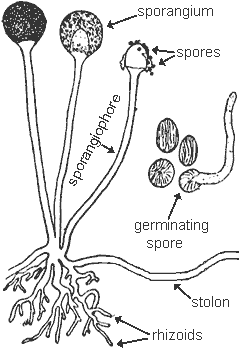
The drawing at the left explains things. Spores, possibly disseminated by the wind, have landed in a moist place where they germinated to form branching, white, threadlike, fuzzy stuff called hyphae. Clumps of a fungus's hyphae are known as mycelium. Special strands of hyphae connecting fungal bodies can be called stolons. Branching rhizoids behave as roots, anchoring the fungus into its substrate (maybe an overripe squash), releasing digestive enzymes, and absorbing nutrients for the fungus. After the fungus's hyphae grow awhile, when conditions are right, new sporangiophores appear, topped with sporangia. New spores asexually form and are released, the spores germinate, and the whole life cycle repeats, producing mycelium genetically identical to that of the mother organism.
Sexual reproduction among "pin molds" seldom is casually observed by us amateur naturalists. It happens when a dark zygospore is produced at the point where two compatible mycelia fuse. Upon germination, a zygospore produces colonies that are genetically different from either parent.
You can see that the "pin mold's" manner of sexually producing zygospores is radically different from the sexual reproduction of spores either of the "higher fungi" or the "sac fungi." On the previously mentioned List of fungal orders, if you check out other fungal divisions, you'll find reproduction strategies just as different from one another as the "higher fungi," the "sac fungi" and the "pin molds" are different from one another.